Commodity flow or domestic trade refers to the flow of commodities through the water, air and rail transport systems in the country. Data on the inflow and outflow of commodities in the different regions of the country are used to construct interregional and inter-industry relation tables. These serve as bases in the formulation and implementation of various regional development programs like countryside development and port planning.
Value and quantity of domestic trade declined
In the third quarter of 2003, the total value of domestic trade decreased by 31.7 percent, resulting to P78.38 billion from P114.79 billion registered during the same period of last year. Water was the major mode of transport with a share of 99.4 percent and 99.5 percent during the third quarters of 2003 and 2002, respectively.

There was a decline in the quantity of commodities traded of 30.3 percent from 10.37 million tons in third quarter 2002 to 7.22 million tons in third quarter 2003. The commodities were traded mostly through water comprising 99.9 percent in third quarter 2003 and 99.8 percent in third quarter 2002.
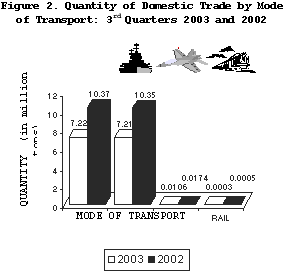
Almost one-third of total domestic trade value was contributed by food and live animals
The bulk of the value of commodities that flowed throughout the country in third quarter 2003 came from food and live animals with value amounting to P22.23 billion (28.4 percent). This was followed by mineral fuels, lubricants and related materials with P16.32 billion (20.8 percent). Machinery and transport equipment was next with P12.87 billion (16.4 percent). Animal and vegetable oils, fats and waxes shared the least value of P777.02 million (1.0 percent) (See Table 1).

Similarly, in the third quarter of 2002, food and live animals dominated the domestic trade with a share of 28.0 percent of the total value (P32.14 billion). Mineral fuels, lubricants and related materials was next with a 19.5 percent share (P22.37 billion). This was followed by machinery and transport equipment with a share of 13.0 percent (P14.91 billion). Contributing the least was animal and vegetable oils, fats and waxes with value amounting only to P777.43 million (See Table 1).

NCR leads in value of domestic trade share
In the third quarter of 2003, NCR accounted for 29.8 percent (P23.36 billion), this being the largest share of the total value of domestic trade. This was followed by Central Luzon with P13.44 billion (17.1 percent) domestic trade share. Eastern Visayas was third, contributing P7.56 billion (9.6 percent). Following closely was Northern Mindanao with P7.50 billion. Contributing the least was Cagayan Valley with only P75 thousand domestic trade share.
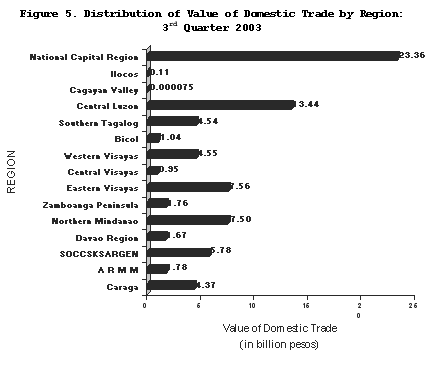
On the other hand, during the third quarter of 2002, Southern Tagalog had the highest domestic trade share at P25.33 billion (22.1 percent). NCR was next with a total value of P24.36 billion (21.2 percent). Central Luzon came up third with P13.45 billion (11.7 percent). Cagayan Valley remained the least contributing region with only P587 thousand domestic trade share.
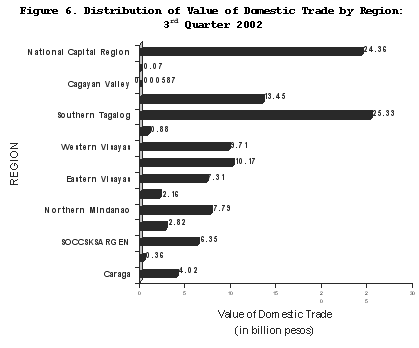
Central Luzon posted favorable trade balance
In the third quarter of 2003, inflows were recorded in Central Luzon at P548.27 million resulting to the most favorable balance of trade at P12.89 billion. Four other regions registered more than a billion positive trade balances: NCR (P3.43 billion), Eastern Visayas (P3.78 billion), SOCCSKSARGEN (P4.52 billion) and Caraga (P3.31 billion). Inflows for Central Visayas amounted to P12.18 billion resulting to an unfavorable balance of trade of -P11.23 billion.
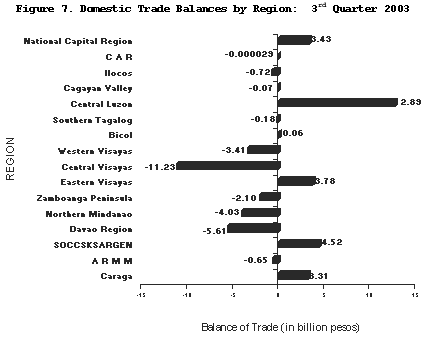
On the other hand, in the third quarter of 2002, Southern Tagalog realized the most favorable trade balance at P14.13 billion. Other regions that posted more than a billion positive trade balances amounting to P12.88 billion, P1.32 billion and P3.83 billion were Central Luzon, Eastern Visayas and SOCCSKSARGEN, respectively. Likewise, Central Visayas suffered an unfavorable balance of trade of -P8.81 billion.
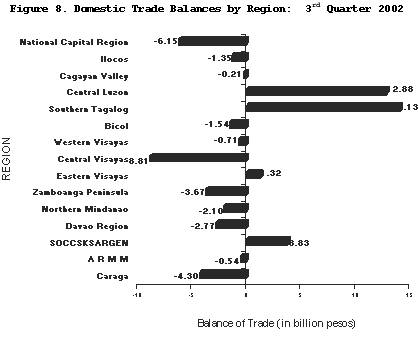
Source: National Statistics Office
Manila, Philippines
